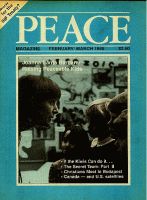
Peace Magazine Feb-Mar 1988, page 24. Some rights reserved.
Search for other articles by Andrew Van Velzen here
Michio Kaku and Daniel Axelrod, To Win a Nuclear War: The Pentagon's Secret War Plans Boston: South End Press 1987, 357pp.
Sizzler, Pincher, Shakedown, Bushwhacker and Broiler. These names reveal a macabre scenario -- the nuclear destruction of the Soviet Union. These are all names of past operational plans of the United States government for the dropping of atomic bombs on the USSR. This is not fiction, but fact. In this shocking book released earlier this year, nuclear physicists Michio Kaku and Daniel Axelrod paint a picture of immorality at the highest levels of the U.S. government.
To Win a Nuclear War destroys the myths about the supposed Soviet threat. The book is based upon declassified U.S. government documents, hence, as Dr. Kaku told me in an interview, "this book cannot be red-baited."
These documents show how the United States has had operational plans to use nuclear weapons against the Soviet Union and some Third World countries from the Middle East to Indochina. Kaku and Axelrod meticulously detail how the U.S. has kept nuclear superiority over the years and how, through the introduction of a whole series of new weapons such as the MX and Trident II, they plan to keep that superiority. Kaku and Axelrod call Star Wars the missing link in the Pentagon's drive to regain first-strike capability.
To Win a Nuclear War shows clearly that, through American advances in anti-satellite technology (ASAT), the Navstar Satellite program, continued emphasis on anti-submarine warfare (ASW), the ELF (Extremely Low Frequency) communications system and advances in missile technology, that the U.S. is striving for a first strike capability. In fact the book talks about one such plan-- "Hypothetical First Strike 1993" -- as one that is still on the books.
Kaku and Axelrod show that the U.S. views nuclear superiority as vital to maintaining influence over world events. They talk about a Rand Corporation term known as Escalation Dominance. In other words, escalating a conflict through nuclear coercion to an end favorable to the U.S. As Kaku and Axelrod have pointedly noted in their book, the ability to dominate the next escalation in violence is the reason 200 warheads are not enough for the U.S. Over the past 40 years the Pentagon has used Escalation Dominance to control conventional situations by threatening to escalate to nuclear weapons.
The book also looks at the formation of post-war U.S. foreign policy and the people involved. It shows the conflicts within elite policy making circles, the split within the Council on Foreign Relations and how, despite myths to the contrary, President Jimmy Carter ended his term with one of the largest military build-ups in U.S. history.
The book ends with a useful chapter on how NATO and the U.S. are superior to the Soviet Union in every aspect of military technology. This is one of the most important books ever written on U.S. military policy. It is a must-read, for it shows who the real terrorists and aggressors are.
Former U.S. Attorney-General Ramsey Clark sums the book in his foreword: "What is to be said of leaders with the mental acuity and moral perceptions revealed by these disclosed words and deeds? They are at best enemies of life without understanding. It doesn't matter whether 'Russians can be trusted,' or what the Russians or anyone else might do. The conduct revealed here cannot be rationally explained or morally tolerated."
By their research Michio Kaku and Daniel Axelrod have created an accessible book that anyone concerned about justice and the fate of the planet must read. They have done us a service.

Peace Magazine Feb-Mar 1988, page 24. Some rights reserved.
Search for other articles by Andrew Van Velzen here